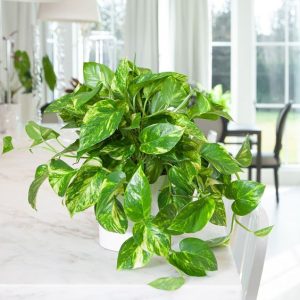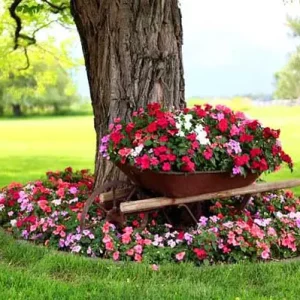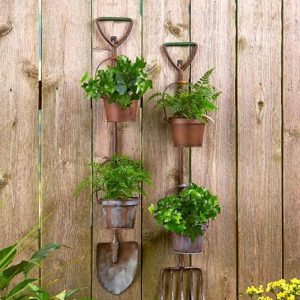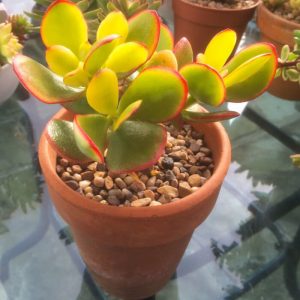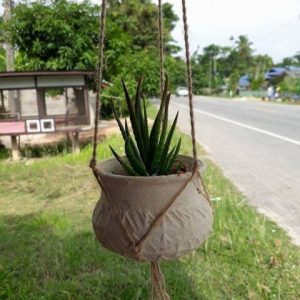A colorful and well-designed front lawn and garden can draw the eye, proving how adding curb appeal landscaping makes entryways more inviting.
Window boxes and planters are classic choices for sprucing up porches and adding extra pizzazz to front walkways. But there are other creative ways to use landscaping to increase curb appeal to your advantage.
Read on for 24 easy landscaping tips that will help you bring new life to flower beds, planters, and your front porch.
Want more gardening tips? Sign up for our free gardening newsletter for our best-growing tips, troubleshooting hacks, and more!
-
01of 24
Add Perennial Plants
:max_bytes(150000):strip_icc():format(webp)/black-eyed-susans-497583765-d6ae1f28996a4d4f8f5c937d1ebdbb45.jpg)
Martin Wahlborg / Getty Images It’s common practice to plant colorful annuals, like pansies and impatiens, in front beds and porch planters for an easy pop of color. But annual plants need to be replaced yearly, which can get expensive and add work to a home gardener’s to-do list.
Instead, try swapping out some annual plants for easy-going perennials that will come back every spring without much fuss. Plants like coneflowers, black-eyed Susan, and yarrow all grow well in pots, planters, and flower beds too!
-
02of 24
Utilize Pollinator Plants
:max_bytes(150000):strip_icc():format(webp)/all-about-pollinator-gardens-5195334-hero-221097e1962548de9f6edfb7c1ff621b.jpg)
The Spruce / Jayme Burrows
Perennial and annual flowers can be grown for aesthetic purposes alone, but you’ll get even more benefits out of your garden if you grow a few pollinator plants too. Flowers like foxgloves, pineapple sage, and bee balm are quite colorful and they’re also highly attractive to bees and hummingbirds.
-
03of 24
Install Bed Edging
:max_bytes(150000):strip_icc():format(webp)/planting-flower-beds-2132568-1-493dbafa00e942bbb311292cca5a34e0.jpg)
The Spruce / Autumn Wood
Bed edging makes flowers beds look more crisp and it helps to keep weeds out. But edging can also protect plants, trees, and shrubs from the damage caused by lawnmowers and weedwhackers. Plastic bed edging is one option, but natural materials like rocks and woven branches (known as wattle edging) can also be used to frame flower beds.
-
04of 24
Plan for the Season
:max_bytes(150000):strip_icc():format(webp)/why-flowers-die-1315929-hero-a0411127bee04fd7accdbf060753c990.jpg)
The Spruce / Sarah Crowley
If you want to keep your front garden bursting with color through the changing seasons, plant flowers that bloom at different times of the year.
For autumn interest, try out plants with color-changing leaves, like viburnums, blueberries, and dogwood. And don’t forget to add some winter interest plants with intriguing bark and berries, such as ninebark, paper birch, and winterberry.
-
05of 24
Hang Window Boxes
:max_bytes(150000):strip_icc():format(webp)/-window-box-flowers-for-sun-1315950-3-098762ab674845b9b9fd7bb6fddef971.jpg)
The Spruce / Autumn Wood
One of the easiest ways to make homes look more appealing is to add a few window boxes brimming with vibrant flowering and foliage plants.
Well-placed window boxes can accentuate architectural features and home colors and they can be switched up with new plants for a seasonal display. Trailing plants, like creeping Jenny and sweet potato vine, are particularly striking in window box arrangements.
-
06of 24
Put Out Planters and Pots
:max_bytes(150000):strip_icc():format(webp)/plants-for-a-front-porch-ferns-32bbf8a5ce644f68b746ab2d160278a0.jpg)
StephanieFrey / Getty Images
Window boxes have their charm, but porch planters and hanging baskets can also be used to add color and interest to the front of homes. Tall pots can be used to frame doors or walkways, or they can be planted with trailing plants to add extra movement and color to porches and patios.
For a classic planter design, pair trailing “spiller” plants with showier “thriller” plants and fill in empty spaces with some “filler” plants as well.
-
07of 24
Plant in Layers
:max_bytes(150000):strip_icc():format(webp)/GettyImages-176448008-55ecc8389b054575882c6c752aa5fce7.jpg)
TanyaRyno / Getty Images
If you want to add more complexity to front flower beds and walkway gardens, plant flowers and foliage plants in layers. Grow tall shrubs and perennials towards the back of flower beds and plant low-growing ornamentals and groundcovers towards the front.
This planting technique makes garden designs look more deliberate, but it will also allow you to experiment with different plants, textures, and colors.
-
08of 24
Include Specimen Plants
:max_bytes(150000):strip_icc():format(webp)/medium-sized-trees-for-small-yards-5119286-07-d62eab6710314d9ebe1527dbdbad5a80.jpg)
The Spruce / Evgeniya Vlasova
Small trees and ornamental shrubs make excellent specimens and they can be used as a centerpiece in flower gardens or to draw attention to an architectural element on the front of your home.
Plants with interesting leaves, unique growth habits, or flowers can be particularly attractive as specimen plants. For instance, weeping beech trees are often grown as specimen trees due to their dark leaf color and cascading branches.
-
09of 24
Play with Colors
:max_bytes(150000):strip_icc():format(webp)/bougainvillea-near-door-big-abd2966b6887458184c7c83f46bc043b.jpg)
George Pachantouris / Getty Images
Plants with brightly colored flowers can make entryways stand out. But for an even bigger impact, choose plants with complementary colors and flowers that accentuate the hues of your home.
If your home has vibrant shutters or a showy mailbox, bring those colors into your flower beds to create a cohesive curb appeal design.
-
10of 24
Grow Foliage Plants
:max_bytes(150000):strip_icc():format(webp)/fall-curb-appeal-ideas-57dfae443df78c9cce250429.jpg)
Getty Images Flowering plants are a must if you want to add interest to the front of your home. However, plants with interesting foliage should not be overlooked.
Ornamental grasses can add movement and texture to garden beds, while plants while variegated or silver-toned leaves can add a splash of unexpected color to planters and window boxes.
-
11of 24
Accentuate Entryways
:max_bytes(150000):strip_icc():format(webp)/Outdoor-Home-Curb-Appeal-56a4a8965f9b58b7d0d8208f.jpg)
Getty Images Placing planters near your front door can make entryways look more welcoming, but you can also add planters, fencing, and hardscape elements to frame front walkways and driveways too.
-
12of 24
Apply Fresh Mulch
:max_bytes(150000):strip_icc():format(webp)/GettyImages-177391388-343f751a4df04c92bb134549a8494037.jpg)
ozgurcoskun / Getty Images
Adding an annual application of mulch keeps garden beds looking tidy, prevents weeds, and insulates the soil so plant roots don’t dry out too quickly.
Wood and bark mulches are the most common choices for ornamental gardens, but pine needles and chopped autumn leaves can also be used, and they’re even more budget-friendly. For best results, apply mulch in a 1 to 3” deep layer and keep it several inches away from plant stems to prevent rot.
-
13of 24
Spruce Up Road Verges
:max_bytes(150000):strip_icc():format(webp)/close-up-of-creeping-phlox--phlox-subulata--blossoms-in-stonewall-in-spring--bavaria--germany-544511341-5c0b4c844cedfd0001e5d597.jpg)
David & Micha Sheldon / Getty Images Hellstrips or road verges are those narrow patches of grass that exist between lawns and roadways.
Sometimes, these areas are owned by cities and towns and homeowners can’t plant in them. But if you own the road verge area in front of your home, that spot may be a prime growing location for sturdy ornamentals that can handle some foot traffic—like creeping thyme and creeping phlox.
-
14of 24
Make an Arbor
:max_bytes(150000):strip_icc():format(webp)/GettyImages-1495173167-252ccd0cc5ea4e84859c038e62c80336.jpg)
M. Long / Getty Images
Arbors delineate space, frame walkways, and add extra interest to the front of homes.
Pre-made arbors are often sold at garden centers, but you can also make your own simple DIY arbor with a cattle panel arch anchored to the soil with t-posts. Once your arbor is in place, plant some vining plants nearby for extra color.
-
15of 24
Design a Mailbox Garden
:max_bytes(150000):strip_icc():format(webp)/vine7-569c4c143df78cafda99f6cf.jpg)
Erin Castillo / Getty Images
Road verges are one often overlooked area for planting, but many homeowners never think to plant around their mailboxes. Creating a small mailbox garden can give you more places to sow small perennial and annual plants, and it can also make your front lawn look more pulled together.
-
16of 24
Remove Weeds
:max_bytes(150000):strip_icc():format(webp)/2SP4104448-2-306762b28df844fe8e059dec792e66c4.jpg)
The Spruce / Sarah Vanbuskirk
Weeds can make even the most well-designed garden look unkempt, but you don’t need herbicides to keep weeds in check.
Mulching will do wonders for controlling weed problems, but you can also bust through weeds in walkways with a pressure washer or horticultural vinegar spray. Of course, hand-pulling is always an option too and it’s even easier with weeding tools like the hori-hori.
-
17of 24
Sow Scented Plants
:max_bytes(150000):strip_icc():format(webp)/philadelphus-coronarius-sweet-mock-orange-white-flowers-in-bloom-on-shrub-branches--flowering-english-dogwood-ornamental-plant-1209667842-b19728466ba2431cb73d2541a5bcb64f.jpg)
Iva Vagnerova / Getty Images Front gardens and planters can be more than just a treat for the eyes. They can also reward our other senses, like our sense of smell. Growing fragrant plants, such as mock orange, lilacs, and heliotropes, near front doors and driveways can make walking to your door after a long day of work a truly transportive experience.
-
18of 24
Use Groundcovers
:max_bytes(150000):strip_icc():format(webp)/creeping-juniper-plant-profile-5070516-05-2b1b7de0339b44a19491f477b49aa4e6.jpg)
The Spruce / Evgeniya Vlasova
Weeds have a way of cropping up in any patch of empty soil. But you can naturally suppress weeds and add extra curb appeal by growing colorful groundcovers in flower beds and other bare spots.
Lily of the valley, foamflower, and wild ginger are easy to keep in shady gardens, while creeping thyme, creeping juniper, and sedums grow well in sun.
-
19of 24
Prune as Needed
:max_bytes(150000):strip_icc():format(webp)/close-up-of-male-hands-trimming-hedge-with-garden-shears-692022401-5acf890bc6733500372f19ca.jpg)
Henry Arden / Getty Images Not all perennials, trees, and shrubs need to be pruned, but some plants can benefit from being cut back from time to time.
Different plants need to be pruned at different times of the year, so always do a bit of research before bringing out your gardening shears. Many pollinators overwinter in old plant debris, so it’s often best to cut back perennials in spring after they finish flowering.
-
20of 24
Consider Hardscaping Elements
:max_bytes(150000):strip_icc():format(webp)/Willowpix-GettyImages-slate-rock-wall-b59ab8120d364dedb8c6c621e70aeebd.jpg)
Willowpix / Getty Images
Walkways and driveways draw the eye in and they can be used to accentuate a home’s curb apparel. But there are other interesting ways to use hardscape elements, such as installing a bird bath or utilizing decorative stones or pavers in garden beds.
A large, well-placed rock can bring a minimalist landscape design together and it can also serve as a conversation piece when neighbors stop by.
-
21of 24
Explore Edible Plants
:max_bytes(150000):strip_icc():format(webp)/Chives-f9dc757af60940df8bdbde3754741588.jpg)
Jasenka Arbanas / Getty Images
Beyond pollinator plants, there are other ways to get more use out of front gardens and planters, and one of the best options is to grow a few edible plants.
Many herbs are colorful and attractive enough to hold their own in window boxes and porch planters. Some common edible plants to grow as ornamentals include tricolor sage, red shiso, and flowering chives.
-
22of 24
Try Solar Powered Lights
:max_bytes(150000):strip_icc():format(webp)/Gardenpathwaytogazeboatnight-3df3214fb8bf4d989ef60ff26cfc04c6.jpg)
cjmckendry / Getty Images
Installing solar-powered lights along walkways and driveway margins can make it much easier to navigate to your door after dark.
These lights can also make your home feel more welcoming and highlight specimen plants and other ornamental features of your home and garden. Best of all, solar-powered lights don’t use any electricity.
-
23of 24
Spread Compost
:max_bytes(150000):strip_icc():format(webp)/hand-holding-shovel-full-of-compost--home-composting-157378019-fb96471b35c041aea9d932589a859097.jpg)
Onfokus / Getty Images Most plants will grow and flower better with a regular application of fertilizer. But you can save on your gardening budget by making your own compost and applying it to garden beds once a year in spring or fall. Sifted compost can also be added to a broadcast spreader and applied to grass lawns to green up patchy spots.
-
24of 24
Think Vertically
:max_bytes(150000):strip_icc():format(webp)/VGSilvaLandscapes-5c52c47bc9e77c00014b0231.jpg)
Silva Landscapes
Vining plants will grow happily up sturdy arbors, but you can also use trellises to fill in blank spaces on the front of your home and train vining flowers to grow up them.
Trellises are typically made of wood or metal and support an assortment of vining ornamentals, including sweet peas, morning glories, and climbing hydrangea.

